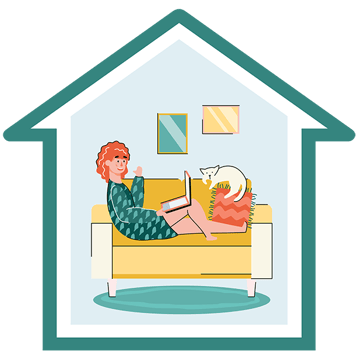Virtual therapy is a new experience for many patients, but there are simple steps they can take to set themselves up for success. ERC Pathlight has seen more than 7,000 patients in Eating Recovery and Pathlight At Home since 2016. Here, two of our experts share what patients have told them about getting the most out of virtual therapy.
- Give yourself permission to ask questions. “It’s normal for a patient to have an initial period in virtual therapy where it feels a little awkward,” says Deborah Michel, PhD, CEDS-S, FAED (she/her/hers), National Clinical Director at Eating Recovery and Pathlight At Home. “Your therapist can help with that, so don’t hesitate to tell the therapist how you’re feeling.”
- Create a good space for your sessions. “Therapists carefully curate the comfort of their offices, and patients should do the same for their virtual sessions,” Dr. Michel advises. “Make a cozy area where you can sit up comfortably with a blanket, pen, paper, water and tissues nearby.”
- Try to stick to the same space. Don’t assume that because a session is virtual you can do it wherever you happen to be, such as your office, a friend’s house or a car. “Having an established location ensures you’re in the right mindset for the session,” says Anne Maguire, LCSW, CEDS (she/her/hers), Clinical Manager of Adult Services at Eating Recovery and Pathlight At Home.
- Make yourself easy to see. “If the light source, such as a window, is behind you, your face will be in shadow. Body language and expressions are part of communication, and your therapist needs to see them,” Maguire says.
- Have a plan B for technology. Care coordinators will walk through the platform in advance with patients to be sure they understand it and that it’s working well. “However, the nature of technology is that glitches can happen,” Dr. Michel says. “You and your therapist should make a plan for switching to a phone call if need be.”
- Eliminate distractions. “Do whatever you need to do to be fully present,” Maguire says. Turn off the self-view camera on the meeting software. View the session on full screen on your computer desktop. Put your phone away and mute notifications. Go to the bathroom ahead of time. Make sure care for kids and pets is adequately covered.
- Know that if you’re scrolling, it will show. “Therapy can be emotionally provoking, and it’s natural for us to want to distract ourselves by opening another screen and looking through it,” Dr. Michel says. “When I see a patient doing that, I’ll ask them what they’re doing. It’s actually a wonderful opportunity to discuss what led to this avoidant behavior and how to work through it.”
- Unmute your voice. “Challenge yourself to share at least once during a group talk or meal,” Maguire says. “Let people get to know you and form relationships. You’ll get more out of the group and be more likely to stay engaged.” If you’re concerned that someone may overhear, get a white noise app for your phone and place it near the door to muffle sounds.
PODCAST: What Is Virtual Treatment Really Like?
Hear Mackenzie Carmichael, whose treatment for an eating disorder pivoted from in-person to virtual IOP in 2020, as she candidly recounts her apprehensions and what she learned about the benefits of virtual treatment.
Listen to the podcast on virtual therapy here.
Learn more about Eating Recovery At Home and Pathlight At Home, our virtual intensive outpatient programs for eating disorders and mood and anxiety disorders. Available and accessible across the nation, these programs are covered in-network by most commercial insurance plans.
